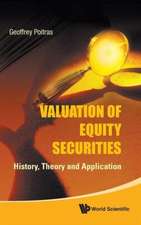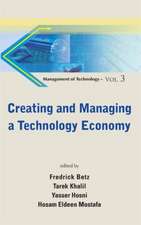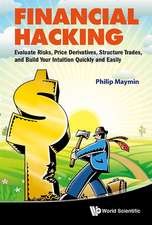The Collapse of the Dollar and How to Profit from It: Make a Fortune by Investing in Gold and Other Hard Assets
Autor James Turk, John A. Rubinoen Limba Engleză Paperback – 31 dec 2007
The United States today is the world’s biggest debtor nation. To finance this mountain of debt, we’re flooding the world with dollars. The resulting oversupply of dollars will cause its value to decline until it is displaced as the world’s dominant currency. Precious metals will soar in value, and gold will reclaim its monetary role at the center of the global financial system.
James Turk, a leading gold authority and the founder of GoldMoney.com, and John Rubino, editor of the popular Web site DollarCollapse.com offer strategies for investing in gold coins, gold stocks, gold-based digital currencies, and other hard assets to create a profitable portfolio.
The Collapse of the Dollar and How to Profit from It is a must read for every citizen and investor.
Preț: 106.23 lei
Nou
Puncte Express: 159
Preț estimativ în valută:
20.33€ • 21.17$ • 17.18£
20.33€ • 21.17$ • 17.18£
Carte disponibilă
Livrare economică 17 februarie-03 martie
Preluare comenzi: 021 569.72.76
Specificații
ISBN-13: 9780385512244
ISBN-10: 0385512244
Pagini: 252
Ilustrații: illustrations
Dimensiuni: 134 x 203 x 18 mm
Greutate: 0.22 kg
Editura: Broadway Business
ISBN-10: 0385512244
Pagini: 252
Ilustrații: illustrations
Dimensiuni: 134 x 203 x 18 mm
Greutate: 0.22 kg
Editura: Broadway Business
Notă biografică
JAMES TURK is founder of GoldMoney.com, which operates the leading digital gold currency payment system. He also publishes the Freemarket Gold & Money Report (fgmr.com), an investment newsletter he founded in 1987. Previously, after a decade with the international department of Chase Manhattan Bank, he managed the commodity department of the Abu Dhabi Investment Authority. His media appearances include CNN, Bloomberg, and CBSMarketWatch, CNBC, Barron’s, the Wall Street Journal, and Financial Sense Online.
JOHN RUBINO is the author of How to Profit from the Coming Real Estate Bust (Rodale, 2003) and Main Street, Not Wall Street (Morrow, 1998). He spent the 1980s as a Wall Street financial analyst, and the 1990s as a regular contributor to theStreet.com, Individual Investor, Ziff/Davis/SmartBusiness, Online Investor, and Consumers Digest. He now writes for Fidelity, Kiplinger's Personal Finance, and CFA.
JOHN RUBINO is the author of How to Profit from the Coming Real Estate Bust (Rodale, 2003) and Main Street, Not Wall Street (Morrow, 1998). He spent the 1980s as a Wall Street financial analyst, and the 1990s as a regular contributor to theStreet.com, Individual Investor, Ziff/Davis/SmartBusiness, Online Investor, and Consumers Digest. He now writes for Fidelity, Kiplinger's Personal Finance, and CFA.
Extras
Chapter 1
ILLUSIONS OF PROSPERITY
During the final two decades of the twentieth century, the U.S. economy was the envy of the world. It created 30 million new jobs while Europe and Japan were creating virtually none. It imposed its technological and ideological will on huge sections of the global marketplace and produced new millionaires the way a Ford plant turns out pickup trucks. U.S. stock prices rose twentyfold during this period, in the process convincing most investors that it would always be so. Toward the end, even the federal government seemed well run, accumulating surpluses big enough to shift the debate from how to allocate scarce resources to how long it would take to eliminate the federal debt.
As the coin of this brave new realm, the dollar became the world’s dominant currency. Foreign central banks accumulated dollars as their main reserve asset. Commodities like oil were denominated in dollars, and emerging countries like Argentina and China linked their currencies to the dollar in the hope of achieving U.S.-like stability. By 2000, there were said to be more $100 bills circulating in Russia than in the U.S.
But as the century ended, so did this extraordinary run. Tech stocks crashed, the Twin Towers fell, and Americans’ sense of omnipotence went the way of their nest eggs. As this is written in early 2004, three million fewer Americans are drawing paychecks. The federal government is borrowing $450 billion each year to finance the war on terror as well as an array of new or expanded social programs. Short-term interest rates have been cut to an incredible one percent, and while growth is finally accelerating, borrowing at every level of society is rising even faster.The dollar, meanwhile, has become the world’s problem currency, falling in value versus other major currencies and plunging versus gold.The whole world is watching, scratching its collective head, and wondering what has changed.
The answer, as will become clear in the next few chapters, is that everything has changed, and nothing has. The spectacular growth of the past two decades, it now turns out, was a mirage generated by the smoke and mirrors of rising debt and the willingness of the rest of the world to accept a flood of new dollars. Just how much the U.S. owes will shock you. But even more shocking is the fact that we’re still at it. Like a family that has maintained its lifestyle by maxing out a series of credit cards,America is at the point where new debt goes to pay off the old rather than to create new wealth. Hence the past few years’ slow growth and steady loss of jobs.
So why say that nothing has changed? Because today’s problems are new only in terms of recent U.S. history. A quick scan of world history reveals them to be depressingly familiar.All great societies pass this way eventually, running up unsustainable debts and printing (or minting) currency in an increasingly desperate attempt to maintain the illusion of prosperity. And all, eventually, find themselves between the proverbial devil and deep blue sea: Either they simply collapse under the weight of their accumulated debt, as did the U.S. and Europe in the 1930s, or they keep running the printing presses until their currencies become worthless and their economies fall into chaos.
This time around, governments the world over have clearly chosen the second option. They’re cutting interest rates, boosting spending, and encouraging the use of modern financial engineering techniques to create a tidal wave of credit. And history teaches that once in motion, this process leads to an inevitable result: Fiat (i.e., government-controlled) currencies will become ever less valuable, until most of us just give up on them altogether. These are strong words, we know. But by the time you’ve finished the next two chapters we think you’ll agree that they are, unfortunately, quite accurate.
Now, what does a collapse in the value of the dollar mean for your finances? Many things, mostly bad but some potentially very good. First, it hurts people on a fixed income, because the value of each dollar they receive plunges. Ditto for those who are owed money, because they’ll be paid back in less-valuable dollars (hence the disaster about to hit many banks). Bonds, which are basically loans to businesses or governments that promise to make fixed monthly payments and then return the principal, will be terrible investments, since they’ll be repaid
in always-depreciating dollars. For stocks and real estate, the picture is mixed, with a weak dollar helping in some ways and hurting in others. We’ll walk you through this labyrinth in Chapter 17.
The only unambiguous winner is gold. For the first 3,000 or so years of human history, gold was, for a variety of still-valid reasons, humanity’s money of choice. As recently as 1970, it was the anchor of the global financial system. And since the world’s economies severed their links to the metal in 1971, it has acted as a kind of shadow currency, rising when the dollar is weak and falling when the dollar is strong. Not surprisingly, gold languished during the 1980s and ’90s, drifting lower as the dollar soared, and being supplanted by the greenback as the standard against which all things financial are measured. But now those roles are about to reverse once again. In the coming decade, as the dollar suffers one of the great meltdowns in monetary history, gold will reclaim its place at the center of the global financial system, and its value, relative to most of today’s national currencies, will soar. The result: Gold coins, gold-mining stocks, and gold-based digital currencies will be vastly better ways to preserve and/or grow wealth than dollar-denominated bonds, stocks, or bank accounts.
That, in a nutshell, is the story.The rest of this book will put some meat on this chapter’s rhetorical bones, but as historians once said of Aristotle, all that follows is mere elaboration.
Chapter 2
FIAT CURRENCIES ARE DOOMED TO FAIL
Before we explain why the dollar is headed for trouble, let’s return to Chapter 1’s assertion that fiat currencies always collapse. An extravagant claim, yes, but also demonstrably true. The history of such currencies is, in fact, an unending litany of failure.
Why is this so? Put simply, governments are fundamentally incapable of maintaining the value of their currencies. Every leader, whether king, president, or prime minister, serves two powerful constituencies: taxpayers angry about what they currently pay and steadfastly opposed to paying more, and those receiving government help
who support greater spending on everything from defense, to roads, to old-age pensions. Alienate either group, and the result can be an abrupt career change. So our hypothetical leader finds himself with two choices, the most obvious of which is to level with his constituents and explain that there’s no such thing as a free lunch. Taxes have to be paid, but government largesse can consume only so much of a healthy economy’s output, so no one person or group can have all they want. This looks simple on paper, but in the real world it makes the leader vulnerable to rivals willing to promise whatever is necessary to gain power.
Our leader doesn’t like this prospect at all, and so turns to his remaining option: borrow to finance some new spending without raising taxes. Then create enough new currency to cover the resulting deficit. The anti-tax and pro-spending folks each get what they want, and no one notices (for a while at least) the slight decline in the value of each individual piece of currency caused by the rising supply. Human nature being what it is, every government eventually chooses this second course. And the result, almost without exception, is a gradual decline in the value of each national currency, which we now know as inflation.
But a little inflation, like a little heroin, is seldom the end of the story. Over time, the gap between tax revenue and the demands placed on government tends to grow, and spending, borrowing, and currency creation begin to expand at increasing rates. Inflation accelerates, and the populace comes to see the process of “debasement” for what it is: the destruction of their savings. They abandon the currency en masse, spending it or converting it to more stable forms of money as fast as possible. The currency’s value plunges (another way of saying prices
soar), wiping out the accumulated savings of a whole generation. Such is the eventual fate of every fiat currency.
To illustrate the process, here are a few of history’s more spectacular currency crises. Note that they all follow roughly the same script, with excessive government spending leading to excessive currency creation, leading, in turn, to inflation and its inevitable consequences.
Rome: Barbarians at the mint. During its five or so centuries of dominance, Rome had ample time to perfect the art of currency debasement. Various leaders made their coins smaller, or chopped wedges or holes in them and melted these bits to make more coins. Or they replaced gold and silver with lesser metals, either outright or by mixing them during the smelting process. By the time Diocletian ascended to the throne in the third century A.D., his predecessors had already replaced the realm’s silver coins with tin-plated copper. And to his credit, Diocletian made an initial stab at reform by issuing coins of more or less pure gold and silver.
Perhaps this newfound honesty would have had the intended stabilizing effect, but the world chose not to cooperate. Rome at the time was a vast, sprawling empire stretching from Spain to present-day Syria, beset on all sides by fast-growing populations of rough Germanic and Asian tribes. Defending the empire was costly, and Diocletian, loath to cross his major constituencies, adopted the now-familiar “guns and butter” approach, hiring thousands of new soldiers while funding numerous public works projects. When he ran short of funds, he simply minted vast new quantities of copper coins and began, once again, debasing his gold and silver coins with copper. When the increasing supply of currency caused prices to rise, he blamed greedy merchants, and in 301 issued his Edict of Prices, which imposed the death penalty on anyone selling for more than the mandated price. Merchants understood the message all too well and instead of raising prices began closing up shop. Diocletian then upped the ante by requiring every man to pursue the occupation of his father. Failure to do so was like a soldier deserting in time of war, said the emperor, and the penalty for this was also death.
Among the many unintended consequences of Diocletian’s edicts was an even more stratified society. The rich, because they understood the monetary debasement taking place and hoarded their pure gold and silver coins (which held their value), became even richer. But the poor were stuck with virtually worthless copper “pecunia” and became increasingly dependent on public assistance. This put an even bigger strain on the treasury and caused even more copper coins to be minted. In 301, when Diocletian imposed price controls, a pound of gold was worth 50,000 denarii (the empire’s currency unit). By 307, a pound of gold was worth 100,000 denarii. By 324, the figure was 300,000 denarii, and by midcentury it was 2 billion. In 410, a financially debilitated Rome fell to the Visigoths.
France: Twice in one century. France in 1715 was a classic victim of bad government. King Louis XIV’s many wars had saddled his successor, Louis XV–only five when he took the throne–with a society that resembled modern-day California. Taxes were high, debt levels were onerous, and people were disgruntled. Then a Scotsman named John Law showed up with a solution.
The disinherited son of a wealthy goldsmith, the handsome and articulate Law had developed a novel theory about money–namely, that the more a government put into circulation, the greater the country’s prosperity. In a preview of some of today’s more destructive economic ideas, he also believed that monetary authorities could, by managing the amount of money in circulation, keep an economy growing briskly without inflation, thus generating plenty of tax revenue while keeping the citizenry fat and happy. He would achieve this nirvana not with gold or silver, the supply of which was limited and therefore hard to manipulate, but rather with a new type of currency made of paper, invented and introduced only years before by the Bank of England. Paper, because its supply could be expanded or contracted at will, was vastly superior to boring old gold and silver coins, said Law, and, managed correctly, would produce a never-ending economic boom.
The now-desperate French gave Law the chance to put theory into practice by allowing him to found a bank, Banque Royale, which could issue paper livres, the currency of the day. Initial results encouraged more experimentation, and Law parlayed his initial goodwill into government contracts to trade with Canada and China and develop France’s vast Louisiana territories. He also had himself named Controller General and Superintendent General of Finance, analogous to today’s U.S.Treasury Secretary and Federal Reserve Chairman, with the power to collect taxes and print money. Then he combined most of these operations into one of the world’s first conglomerates, Compagnie d’Occident, popularly known as the Mississippi Company.
Now in nearly complete control of French finances, Law decreed that henceforth land and stock could be used as collateral for loans, enabling borrowers to enter his bank with a property deed or stock certificate and walk out with newly printed currency. The result was a self-reinforcing cycle, in which people borrowed against their land and stocks to buy more land and stocks, driving up prices and creating collateral for new loans (not unlike today’s U.S. real estate market, about which more will be said shortly).
Mississippi Company stock–the glitziest growth stock of its day–soared from its original price of 500 livres in January 1719 to 20,000 livres by year-end 1720. Law’s early investors made fortunes, and ordinary Frenchmen began quitting their jobs to become that era’s version of day traders.As Charles Mackay recounts in his 1841 classic Extraordinary Popular Delusions and the Madness of Crowds, the action was so frenetic
on Paris’s curbside stock exchange that a hunchbacked man made a nice living renting out his broad back as a mobile writing table for frenzied stock traders. Law became an international celebrity and, on paper, one of the world’s richest men.
But within the year, the paper livres cascading from Law’s printing presses caused the price of virtually everything in France to soar.And in an early example of what we now know as Gresham’s Law (bad money drives good money out of circulation when the government insists that they trade at the same value), French consumers began hoarding gold and silver coins and spending paper the minute they received it. By January 1720, prices in paper livre terms were rising at a monthly rate of 23 percent.
That same month, two royal princes decided to cash in their Mississippi Company shares, and others began to follow suit, sending the price down sharply. Law responded by printing even more paper money, while using his official powers to prohibit ownership of more than 500 livres in gold or silver. This thoroughly spooked the markets, sending Mississippi Company stock–and the value of the paper livre–through the floor. By the end of 1721, the stock was back to its original price of 500 livres, the French economy was in a shambles, and Law was history. Stripped of wealth and power, he fled to Italy, where he died penniless in 1729.
From the Hardcover edition.
ILLUSIONS OF PROSPERITY
During the final two decades of the twentieth century, the U.S. economy was the envy of the world. It created 30 million new jobs while Europe and Japan were creating virtually none. It imposed its technological and ideological will on huge sections of the global marketplace and produced new millionaires the way a Ford plant turns out pickup trucks. U.S. stock prices rose twentyfold during this period, in the process convincing most investors that it would always be so. Toward the end, even the federal government seemed well run, accumulating surpluses big enough to shift the debate from how to allocate scarce resources to how long it would take to eliminate the federal debt.
As the coin of this brave new realm, the dollar became the world’s dominant currency. Foreign central banks accumulated dollars as their main reserve asset. Commodities like oil were denominated in dollars, and emerging countries like Argentina and China linked their currencies to the dollar in the hope of achieving U.S.-like stability. By 2000, there were said to be more $100 bills circulating in Russia than in the U.S.
But as the century ended, so did this extraordinary run. Tech stocks crashed, the Twin Towers fell, and Americans’ sense of omnipotence went the way of their nest eggs. As this is written in early 2004, three million fewer Americans are drawing paychecks. The federal government is borrowing $450 billion each year to finance the war on terror as well as an array of new or expanded social programs. Short-term interest rates have been cut to an incredible one percent, and while growth is finally accelerating, borrowing at every level of society is rising even faster.The dollar, meanwhile, has become the world’s problem currency, falling in value versus other major currencies and plunging versus gold.The whole world is watching, scratching its collective head, and wondering what has changed.
The answer, as will become clear in the next few chapters, is that everything has changed, and nothing has. The spectacular growth of the past two decades, it now turns out, was a mirage generated by the smoke and mirrors of rising debt and the willingness of the rest of the world to accept a flood of new dollars. Just how much the U.S. owes will shock you. But even more shocking is the fact that we’re still at it. Like a family that has maintained its lifestyle by maxing out a series of credit cards,America is at the point where new debt goes to pay off the old rather than to create new wealth. Hence the past few years’ slow growth and steady loss of jobs.
So why say that nothing has changed? Because today’s problems are new only in terms of recent U.S. history. A quick scan of world history reveals them to be depressingly familiar.All great societies pass this way eventually, running up unsustainable debts and printing (or minting) currency in an increasingly desperate attempt to maintain the illusion of prosperity. And all, eventually, find themselves between the proverbial devil and deep blue sea: Either they simply collapse under the weight of their accumulated debt, as did the U.S. and Europe in the 1930s, or they keep running the printing presses until their currencies become worthless and their economies fall into chaos.
This time around, governments the world over have clearly chosen the second option. They’re cutting interest rates, boosting spending, and encouraging the use of modern financial engineering techniques to create a tidal wave of credit. And history teaches that once in motion, this process leads to an inevitable result: Fiat (i.e., government-controlled) currencies will become ever less valuable, until most of us just give up on them altogether. These are strong words, we know. But by the time you’ve finished the next two chapters we think you’ll agree that they are, unfortunately, quite accurate.
Now, what does a collapse in the value of the dollar mean for your finances? Many things, mostly bad but some potentially very good. First, it hurts people on a fixed income, because the value of each dollar they receive plunges. Ditto for those who are owed money, because they’ll be paid back in less-valuable dollars (hence the disaster about to hit many banks). Bonds, which are basically loans to businesses or governments that promise to make fixed monthly payments and then return the principal, will be terrible investments, since they’ll be repaid
in always-depreciating dollars. For stocks and real estate, the picture is mixed, with a weak dollar helping in some ways and hurting in others. We’ll walk you through this labyrinth in Chapter 17.
The only unambiguous winner is gold. For the first 3,000 or so years of human history, gold was, for a variety of still-valid reasons, humanity’s money of choice. As recently as 1970, it was the anchor of the global financial system. And since the world’s economies severed their links to the metal in 1971, it has acted as a kind of shadow currency, rising when the dollar is weak and falling when the dollar is strong. Not surprisingly, gold languished during the 1980s and ’90s, drifting lower as the dollar soared, and being supplanted by the greenback as the standard against which all things financial are measured. But now those roles are about to reverse once again. In the coming decade, as the dollar suffers one of the great meltdowns in monetary history, gold will reclaim its place at the center of the global financial system, and its value, relative to most of today’s national currencies, will soar. The result: Gold coins, gold-mining stocks, and gold-based digital currencies will be vastly better ways to preserve and/or grow wealth than dollar-denominated bonds, stocks, or bank accounts.
That, in a nutshell, is the story.The rest of this book will put some meat on this chapter’s rhetorical bones, but as historians once said of Aristotle, all that follows is mere elaboration.
Chapter 2
FIAT CURRENCIES ARE DOOMED TO FAIL
Before we explain why the dollar is headed for trouble, let’s return to Chapter 1’s assertion that fiat currencies always collapse. An extravagant claim, yes, but also demonstrably true. The history of such currencies is, in fact, an unending litany of failure.
Why is this so? Put simply, governments are fundamentally incapable of maintaining the value of their currencies. Every leader, whether king, president, or prime minister, serves two powerful constituencies: taxpayers angry about what they currently pay and steadfastly opposed to paying more, and those receiving government help
who support greater spending on everything from defense, to roads, to old-age pensions. Alienate either group, and the result can be an abrupt career change. So our hypothetical leader finds himself with two choices, the most obvious of which is to level with his constituents and explain that there’s no such thing as a free lunch. Taxes have to be paid, but government largesse can consume only so much of a healthy economy’s output, so no one person or group can have all they want. This looks simple on paper, but in the real world it makes the leader vulnerable to rivals willing to promise whatever is necessary to gain power.
Our leader doesn’t like this prospect at all, and so turns to his remaining option: borrow to finance some new spending without raising taxes. Then create enough new currency to cover the resulting deficit. The anti-tax and pro-spending folks each get what they want, and no one notices (for a while at least) the slight decline in the value of each individual piece of currency caused by the rising supply. Human nature being what it is, every government eventually chooses this second course. And the result, almost without exception, is a gradual decline in the value of each national currency, which we now know as inflation.
But a little inflation, like a little heroin, is seldom the end of the story. Over time, the gap between tax revenue and the demands placed on government tends to grow, and spending, borrowing, and currency creation begin to expand at increasing rates. Inflation accelerates, and the populace comes to see the process of “debasement” for what it is: the destruction of their savings. They abandon the currency en masse, spending it or converting it to more stable forms of money as fast as possible. The currency’s value plunges (another way of saying prices
soar), wiping out the accumulated savings of a whole generation. Such is the eventual fate of every fiat currency.
To illustrate the process, here are a few of history’s more spectacular currency crises. Note that they all follow roughly the same script, with excessive government spending leading to excessive currency creation, leading, in turn, to inflation and its inevitable consequences.
Rome: Barbarians at the mint. During its five or so centuries of dominance, Rome had ample time to perfect the art of currency debasement. Various leaders made their coins smaller, or chopped wedges or holes in them and melted these bits to make more coins. Or they replaced gold and silver with lesser metals, either outright or by mixing them during the smelting process. By the time Diocletian ascended to the throne in the third century A.D., his predecessors had already replaced the realm’s silver coins with tin-plated copper. And to his credit, Diocletian made an initial stab at reform by issuing coins of more or less pure gold and silver.
Perhaps this newfound honesty would have had the intended stabilizing effect, but the world chose not to cooperate. Rome at the time was a vast, sprawling empire stretching from Spain to present-day Syria, beset on all sides by fast-growing populations of rough Germanic and Asian tribes. Defending the empire was costly, and Diocletian, loath to cross his major constituencies, adopted the now-familiar “guns and butter” approach, hiring thousands of new soldiers while funding numerous public works projects. When he ran short of funds, he simply minted vast new quantities of copper coins and began, once again, debasing his gold and silver coins with copper. When the increasing supply of currency caused prices to rise, he blamed greedy merchants, and in 301 issued his Edict of Prices, which imposed the death penalty on anyone selling for more than the mandated price. Merchants understood the message all too well and instead of raising prices began closing up shop. Diocletian then upped the ante by requiring every man to pursue the occupation of his father. Failure to do so was like a soldier deserting in time of war, said the emperor, and the penalty for this was also death.
Among the many unintended consequences of Diocletian’s edicts was an even more stratified society. The rich, because they understood the monetary debasement taking place and hoarded their pure gold and silver coins (which held their value), became even richer. But the poor were stuck with virtually worthless copper “pecunia” and became increasingly dependent on public assistance. This put an even bigger strain on the treasury and caused even more copper coins to be minted. In 301, when Diocletian imposed price controls, a pound of gold was worth 50,000 denarii (the empire’s currency unit). By 307, a pound of gold was worth 100,000 denarii. By 324, the figure was 300,000 denarii, and by midcentury it was 2 billion. In 410, a financially debilitated Rome fell to the Visigoths.
France: Twice in one century. France in 1715 was a classic victim of bad government. King Louis XIV’s many wars had saddled his successor, Louis XV–only five when he took the throne–with a society that resembled modern-day California. Taxes were high, debt levels were onerous, and people were disgruntled. Then a Scotsman named John Law showed up with a solution.
The disinherited son of a wealthy goldsmith, the handsome and articulate Law had developed a novel theory about money–namely, that the more a government put into circulation, the greater the country’s prosperity. In a preview of some of today’s more destructive economic ideas, he also believed that monetary authorities could, by managing the amount of money in circulation, keep an economy growing briskly without inflation, thus generating plenty of tax revenue while keeping the citizenry fat and happy. He would achieve this nirvana not with gold or silver, the supply of which was limited and therefore hard to manipulate, but rather with a new type of currency made of paper, invented and introduced only years before by the Bank of England. Paper, because its supply could be expanded or contracted at will, was vastly superior to boring old gold and silver coins, said Law, and, managed correctly, would produce a never-ending economic boom.
The now-desperate French gave Law the chance to put theory into practice by allowing him to found a bank, Banque Royale, which could issue paper livres, the currency of the day. Initial results encouraged more experimentation, and Law parlayed his initial goodwill into government contracts to trade with Canada and China and develop France’s vast Louisiana territories. He also had himself named Controller General and Superintendent General of Finance, analogous to today’s U.S.Treasury Secretary and Federal Reserve Chairman, with the power to collect taxes and print money. Then he combined most of these operations into one of the world’s first conglomerates, Compagnie d’Occident, popularly known as the Mississippi Company.
Now in nearly complete control of French finances, Law decreed that henceforth land and stock could be used as collateral for loans, enabling borrowers to enter his bank with a property deed or stock certificate and walk out with newly printed currency. The result was a self-reinforcing cycle, in which people borrowed against their land and stocks to buy more land and stocks, driving up prices and creating collateral for new loans (not unlike today’s U.S. real estate market, about which more will be said shortly).
Mississippi Company stock–the glitziest growth stock of its day–soared from its original price of 500 livres in January 1719 to 20,000 livres by year-end 1720. Law’s early investors made fortunes, and ordinary Frenchmen began quitting their jobs to become that era’s version of day traders.As Charles Mackay recounts in his 1841 classic Extraordinary Popular Delusions and the Madness of Crowds, the action was so frenetic
on Paris’s curbside stock exchange that a hunchbacked man made a nice living renting out his broad back as a mobile writing table for frenzied stock traders. Law became an international celebrity and, on paper, one of the world’s richest men.
But within the year, the paper livres cascading from Law’s printing presses caused the price of virtually everything in France to soar.And in an early example of what we now know as Gresham’s Law (bad money drives good money out of circulation when the government insists that they trade at the same value), French consumers began hoarding gold and silver coins and spending paper the minute they received it. By January 1720, prices in paper livre terms were rising at a monthly rate of 23 percent.
That same month, two royal princes decided to cash in their Mississippi Company shares, and others began to follow suit, sending the price down sharply. Law responded by printing even more paper money, while using his official powers to prohibit ownership of more than 500 livres in gold or silver. This thoroughly spooked the markets, sending Mississippi Company stock–and the value of the paper livre–through the floor. By the end of 1721, the stock was back to its original price of 500 livres, the French economy was in a shambles, and Law was history. Stripped of wealth and power, he fled to Italy, where he died penniless in 1729.
From the Hardcover edition.
Recenzii
“There is a crisis coming, and it will cause a collapse in the mountain of credit fostered by the monopoly central banks of the world. Read this book and find out how you can protect yourself while there’s still time.” – Robert R. Prechter, author of the bestseller CONQUER THE CRASH.
Descriere
Ordinary investors will learn how to preserve and increase their wealth by investing in gold coins, gold mining stocks and gold-based digital currencies. The authors delineate the potential profits and the risks involved.






















